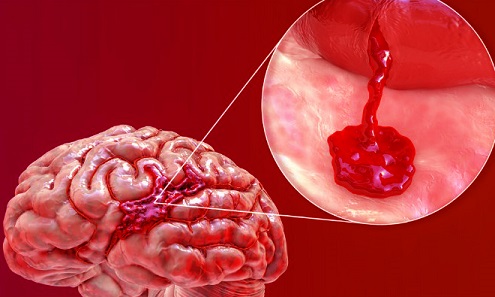Nikhil Prasad Fact checked by:Thailand Medical News Team Dec 01, 2024 1 year, 2 weeks, 6 days, 17 hours, 24 minutes ago
Medical News: Introduction to Subarachnoid Hemorrhage and COVID19
Since the onset of the COVID-19 pandemic, researchers have focused on understanding its wide-ranging complications. Neurological issues have been observed in many COVID-19 patients, with nearly a third experiencing symptoms like stroke. Among these, subarachnoid hemorrhage (SAH) - a severe form of brain bleeding - has raised concerns. A new study explored the link between SARS-CoV-2 infection and SAH, offering insights into how the virus might contribute to this dangerous condition.
 Romanian Study Warns That COVID-19 Increases Risk of Brain Bleeding
Romanian Study Warns That COVID-19 Increases Risk of Brain Bleeding
The study, conducted by experts from Victor Babes University of Medicine and Pharmacy and Clinical Emergency County Hospital in Romania, along with researchers from the University of Kassala in Sudan, provides a comprehensive review of 107 documented cases of SAH linked to COVID-19. This
Medical News report delves into their findings to make the information accessible to everyone.
What the Study Found About SAH in COVID19 Patients
Subarachnoid hemorrhage (SAH) occurs when bleeding occurs in the space between the brain and the thin tissues covering it. While aneurysms are a common cause, the study identified two types of SAH in COVID-19 patients - aneurysmal (aSAH) and non-aneurysmal (non-aSAH). Among the cases analyzed, 30 were aneurysmal, 52 were non-aneurysmal (confirmed by imaging), and 25 lacked vascular imaging for classification.
The timing of SAH varied significantly. For some, it occurred concurrently with COVID-19 infection, while for others, it appeared weeks later. Researchers noted that patients with severe COVID-19 were more likely to experience SAH. About half of the aSAH cases occurred in those with severe infection, while this was true for 75% of non-aSAH cases.
The study detailed inflammatory markers and coagulation issues in many patients. Non-aSAH cases were particularly associated with complications like cerebral venous sinus thrombosis (CVST), reversible cerebral vasoconstriction syndrome (RCVS), and posterior reversible encephalopathy syndrome (PRES).
Mechanisms Behind SAH in COVID19 Patients
The mechanisms linking COVID-19 to SAH are complex. Researchers hypothesize that the infection triggers a hyperinflammatory state, often referred to as a "cytokine storm." This storm can weaken blood vessels, making them more prone to rupture. SARS-CoV-2's affinity for angiotensin-converting enzyme 2 (ACE2) receptors in blood vessels may also lead to localized inflammation and vascular damage.
The study highlights that additional factors, such as uncontrolled hypertension and frequent coughing, may exacerbate the risk of aneurysm rupture. Non-aSAH cases often involve conditions like arterial dissection or thrombosis, complicating the clinical picture further.
Key Patient Demographics and Symptoms
The study revealed that SAH predominantly affected middle-aged adults, with a slight vari
ation in age distribution between the aSAH and non-aSAH groups. Headaches were the most common symptom in aSAH cases, while non-aSAH cases often presented with coma or severe neurological deficits.
Diagnostic and Treatment Challenges
Diagnosing SAH in COVID-19 patients poses significant challenges, particularly because symptoms like headaches and altered consciousness are also common in severe COVID-19 cases. Imaging techniques such as CT and MRI play a critical role in identifying the source of bleeding and determining the type of SAH.
Treatment is equally complicated. While some patients received standard care for SAH, others required tailored treatments to address COVID-19-related complications. Anticoagulants, often used to manage clotting risks in COVID-19 patients, can increase bleeding risks, adding to the complexity of treatment decisions.
Conclusions and Implications
The study underscores the importance of recognizing SAH as a potential complication in COVID-19 patients, especially those with severe infection. Early diagnosis and a multidisciplinary approach to treatment are essential for improving outcomes.
The findings also highlight the need for further research to understand the interplay between SARS-CoV-2 and vascular health. Establishing an international registry for such cases could provide valuable data, enabling clinicians to develop more effective management strategies.
For patients and caregivers, this study serves as a reminder of the wide-ranging effects of COVID-19. While rare, SAH is a serious condition that requires prompt medical attention. Staying informed and seeking timely care can make a significant difference.
The study findings were published in the peer-reviewed journal: SAGE Open Medicine.
https://journals.sagepub.com/doi/full/10.1177/20503121241299643
For the latest COVID-19 News, keep on logging to Thailand
Medical News.
Read Also:
https://www.thailandmedical.news/news/one-third-of-all-exposed-to-covid-19-likely-to-develop-cerebral-microbleeds
https://www.thailandmedical.news/news/cerebral-microbleeds-increases-risk-of-stroke-or-dementia
https://www.thailandmedical.news/news/individuals-with-acute-ischemic-stroke-and-covid-19-showed-higher-rates-of-intracranial-bleeding-issues-and-worse-clinical-outcomes
https://www.thailandmedical.news/news/new-non-human-primate-study-alarmingly-reveals-that-sars-cov-2-infections-can-lead-to-brain-inflammation,-brain-hypoxia,-brain-bleeding-and-also-strok
